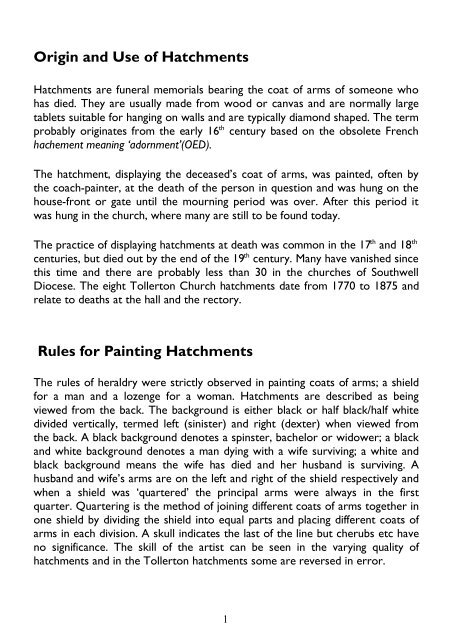here - St Peter's Church, Tollerton
here - St Peter's Church, Tollerton
here - St Peter's Church, Tollerton
You also want an ePaper? Increase the reach of your titles
YUMPU automatically turns print PDFs into web optimized ePapers that Google loves.
Origin and Use of Hatchments<br />
Hatchments are funeral memorials bearing the coat of arms of someone who<br />
has died. They are usually made from wood or canvas and are normally large<br />
tablets suitable for hanging on walls and are typically diamond shaped. The term<br />
probably originates from the early 16 th century based on the obsolete French<br />
hachement meaning ‘adornment’(OED).<br />
The hatchment, displaying the deceased’s coat of arms, was painted, often by<br />
the coach-painter, at the death of the person in question and was hung on the<br />
house-front or gate until the mourning period was over. After this period it<br />
was hung in the church, w<strong>here</strong> many are still to be found today.<br />
The practice of displaying hatchments at death was common in the 17 th and 18 th<br />
centuries, but died out by the end of the 19 th century. Many have vanished since<br />
this time and t<strong>here</strong> are probably less than 30 in the churches of Southwell<br />
Diocese. The eight <strong>Tollerton</strong> <strong>Church</strong> hatchments date from 1770 to 1875 and<br />
relate to deaths at the hall and the rectory.<br />
Rules for Painting Hatchments<br />
The rules of heraldry were strictly observed in painting coats of arms; a shield<br />
for a man and a lozenge for a woman. Hatchments are described as being<br />
viewed from the back. The background is either black or half black/half white<br />
divided vertically, termed left (sinister) and right (dexter) when viewed from<br />
the back. A black background denotes a spinster, bachelor or widower; a black<br />
and white background denotes a man dying with a wife surviving; a white and<br />
black background means the wife has died and her husband is surviving. A<br />
husband and wife’s arms are on the left and right of the shield respectively and<br />
when a shield was ‘quartered’ the principal arms were always in the first<br />
quarter. Quartering is the method of joining different coats of arms together in<br />
one shield by dividing the shield into equal parts and placing different coats of<br />
arms in each division. A skull indicates the last of the line but cherubs etc have<br />
no significance. The skill of the artist can be seen in the varying quality of<br />
hatchments and in the <strong>Tollerton</strong> hatchments some are reversed in error.<br />
1


